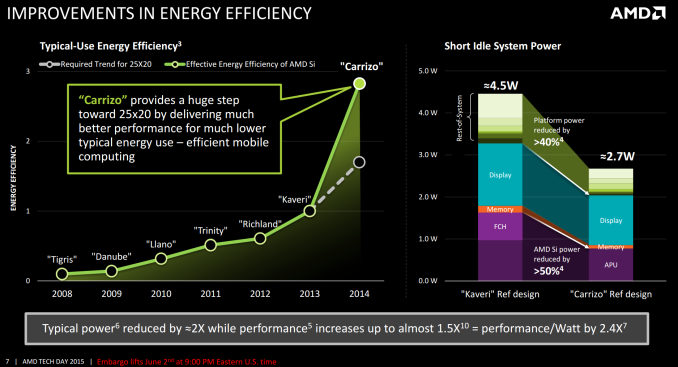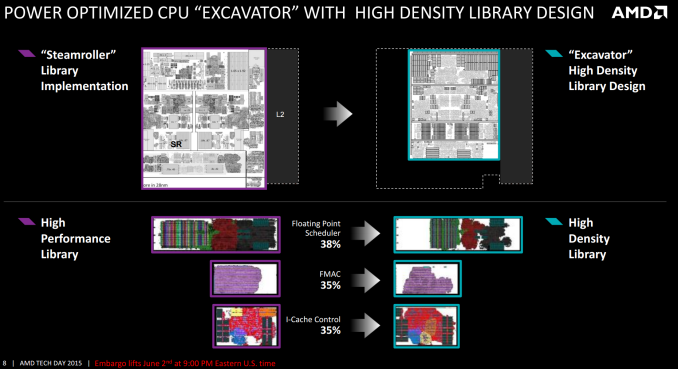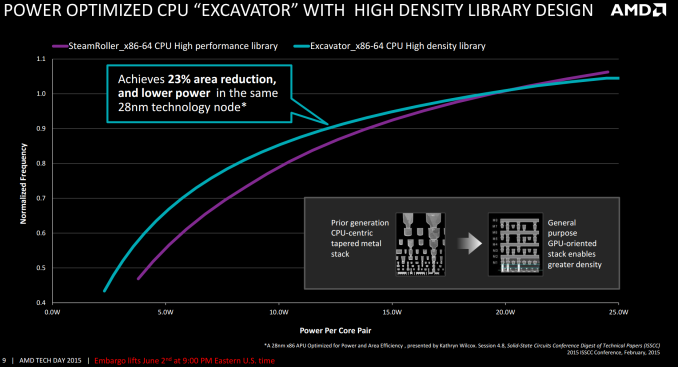AMD Launches Carrizo: The Laptop Leap of Efficiency and Architecture Updates
by Ian Cutress on June 2, 2015 9:00 PM ESTEfficiency and Die Area Savings
AMD’s take home message in all of this is efficiency. We a being quoted a performance per watt increase of 2.4x, coming from typical power draw savings of 2x and performance increase of almost 1.5x for 23% less die area, all in one go.
Ultimately this all helps AMD’s plan to be 25x more efficient with their APUs by 2020, and the cumulative bar chart on the right is how mobile improvements from all sides are being realized. Migrating the southbridge on die severely reduces its idle power consumption to almost zero and can help efficiencies elsewhere in the system. The APU general use and memory controllers are the next targets, but the common constant here is the display. Using a low power display might give battery life in exchange for quality, and there is only so much power you can save at the SoC level. In time, the display will be the main focus of power saving for these devices.
A big part of the reduction in die area comes from the set of high density libraries being used by AMD. Above were three examples provided where >33% gains were made in silicon area. Typically using a high density library design is a double edged sword – it reduces die area and potentially leaves more area for other things, but the caveat is that it may be more prone to defects in construction, require additional latency or have a different frequency/voltage profile. AMD assures us that these changes are at least like-for-like but most of them contain other improvements as well.
It’s worth noting here that AMD has described the high density library project internally as the equivalent of a moonshot, essentially the developers were part of a ‘skunkworks’ division attempting to make drastic changes in order to improve performance. The high density library is one such successful project from that.
With the new libraries, comparing Excavator to Steamroller shows the effect moving designs has. The power/frequency curve below 20W per module shifts to higher frequency/lower power, whereas losses are observed above 20W. However for 15W per module, this means either a 10%+ power reduction at the same frequency or a 5% increase in frequency for the same power. Should AMD release dual thread / single core APUs in the 7.5W region, this is where most of the gains are (as noted in the comments, the dual module designs are at 7.5W per module, meaning that what we should see in devices is already in the peak value for gains and benefits such as 25% frequency or 33% power). As also seen in the insert, the silicon stack has been adjusted to a more general purpose orientation. I could comment that this makes the CPU and GPU work better together, but I have no way of verifying this. AMD states the change in the silicon stack makes production slightly easier but also helps with achieving the higher density Excavator exhibits.













137 Comments
View All Comments
Refuge - Wednesday, June 3, 2015 - link
Built my mother a new system from her old scraps with a new A8, she loves that desktop, and when she put an SSD in it finally she loved it ten times more. the upgrade only cost her $300, for CPU, Mobo, RAM. Threw it together in 45 minutes, and she hasn't had a problem with it in 2 years so far.nathanddrews - Wednesday, June 3, 2015 - link
I prefer the following setup:1. Beast-mode, high-performance desktop for gaming, video editing, etc.
2. Low-power, cheap notebook/tablet for In-Home Steam Streaming and light gaming (720p) on the go.
In my use case, as long as I can load and play the game (20-30fps for RTS, 30fps+ for everything else) on a plane ride or some other scenario without AC access, I'm not really concerned with the AA or texture quality. I still want to get the best experience possible, but balanced against the cheapest possible price. The sub-$300 range is ideal for me.
AS118 - Wednesday, June 3, 2015 - link
Yeah, that's my thing as well. High resolutions at work, and at home, 768p or 900p's just fine, especially for gaming.I also recommend AMD to friends and relatives who want laptops and stuff that can do casual gaming for cheap.
FlushedBubblyJock - Tuesday, June 9, 2015 - link
Why go amd when HD3000 does just fine gaming and the added power of the intel cpu is an awesome boost overall ...Valantar - Wednesday, June 3, 2015 - link
1366*768 on anything larger than 13" looks a mess, but in a cheap laptop I'd rather have a 13*7 IPS for the viewing angles and better visuals than a cheap FHD TN panel - bad viewing angles especially KILL the experience of using a laptop. Still, 13*7 is pretty lousy for anything other than multimedia - it's simply too short to fit a useful amount of text vertically. A decent compromise would be moving up to 1600*900 as the standard resolution on >11" displays. Or, of course, moving to 3:2 or 4:3 displays, which would make the resolution 1366*911 or 1366*1024 and provide ample vertical space. Still, 13*7 TN panels need to go away. Now.yankeeDDL - Wednesday, June 3, 2015 - link
Like I said, to each his own. I have a Lenovo Z50 which I paid less than $470 with the A10 7300.Quite frankly, I could not be happier and I think it provides a massive value for that money.
Sure, a larger battery and a better screen would not hurt, but for hustling it around the house, or bring it to friend/family house, watch movies, play games at native resolution, it is fantastic.
It's no road warrior, for sure (heavy and the battery life doesn't go much beyond 3hrs of "serious" use) but playing at 1366*768 on something that weights 5 pounds and costs noticeably less than $500, is quite amazing. Impossible on an Intel+discrete graphics, as far as I know.
FlushedBubblyJock - Tuesday, June 9, 2015 - link
Nope, HD3000 plays just fineMargalus - Wednesday, June 3, 2015 - link
I'd rather have a cheaper 15.6" 1366x768 TN panel over a more expensive smaller ips panel.UtilityMax - Wednesday, June 3, 2015 - link
1366x768 is fine for movies and games. But it's a bad resolution for reading text or viewing images on the web, since you see pixels the size of moon crater.BrokenCrayons - Thursday, June 4, 2015 - link
I understand there's going to be a variety of differing opinions on the idea of seeing individual pixels. As far as I'm concerned, seeing individual pixels isn't a dreadful or horrific thing. In fact, to me it simply doesn't matter. I'm busy living my meat world life and enjoying whatever moments I have with family and friends so I don't give the ability to discern an individual pixel so much as a second thought. It is an insignificant part of my life, but what isn't is the associated decline in battery life (on relative terms) required to drive additional, utterly unnecessary pixels and to push out sufficient light as a result of the larger multitude of them. That sort of thing is marginally annoying -- then again, I still just don't care that much one way or another aside from noticing that a lot of people are very much infatuated with an insignificant, nonsense problem.